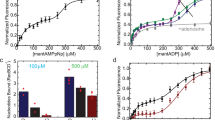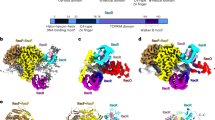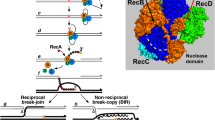Abstract
Escherichia coli RecBCD is a heterotrimeric helicase/nuclease that catalyses a complex reaction in which double-strand breaks in DNA are processed for repair by homologous recombination1. For some time it has been clear that the RecB subunit possesses a 3′ → 5′ DNA helicase activity2,3,4, which was thought to drive DNA translocation and unwinding in the RecBCD holoenzyme. Here we show that purified RecD protein is also a DNA helicase, but one that possesses a 5′ → 3′ polarity. We also show that the RecB and RecD helicases are both active in intact RecBCD, because the enzyme remains capable of processive DNA unwinding when either of these subunits is inactivated by mutation. These findings point to a bipolar translocation model for RecBCD in which the two DNA helicases are complementary, travelling with opposite polarities, but in the same direction, on each strand of the antiparallel DNA duplex. This bipolar motor organization helps to explain various biochemical properties of RecBCD, notably its exceptionally high speed and processivity, and offers a mechanistic insight into aspects of RecBCD function.
This is a preview of subscription content, access via your institution
Access options
Subscribe to this journal
Receive 51 print issues and online access
$199.00 per year
only $3.90 per issue
Buy this article
- Purchase on Springer Link
- Instant access to full article PDF
Prices may be subject to local taxes which are calculated during checkout





Similar content being viewed by others
References
Arnold, D. A. & Kowalczykowski, S. C. in Encyclopedia of Life Sciences http://www.els.net (Nature Publishing Group, London, 1999)
Phillips, R. J., Hickleton, D. C., Boehmer, P. E. & Emmerson, P. T. The RecB protein of Escherichia coli translocates along single-stranded DNA in the 3′ to 5′ direction: a proposed ratchet mechanism. Mol. Gen. Genet. 254, 319–329 (1997)
Yu, M., Souaya, J. & Julin, D. A. The 30-kDa C-terminal domain of the RecB protein is critical for the nuclease activity, but not the helicase activity, of the RecBCD enzyme from Escherichia coli. Proc. Natl Acad. Sci. USA 95, 981–986 (1998)
Bianco, P. R. & Kowalczykowski, S. C. Step size measurements on the translocation mechanism of the RecBC DNA helicase. Nature 405, 368–372 (2000)
Dixon, D. A. & Kowalczykowski, S. C. The recombination hotspot Chi is a regulatory sequence that acts by attenuating the nuclease activity of the E. coli RecBCD enzyme. Cell 73, 87–96 (1993)
Bianco, P. R. & Kowalczykowski, S. C. The recombination hotspot Chi is recognized by the translocating RecBCD enzyme as the single strand of DNA containing the sequence 5′-GCTGGTGG-3′. Proc. Natl Acad. Sci. USA 94, 6706–6711 (1997)
Anderson, D. G. & Kowalczykowski, S. C. The recombination hot spot Chi is a regulatory element that switches the polarity of DNA degradation by the RecBCD enzyme. Genes Dev. 11, 571–581 (1997)
Anderson, D. G. & Kowalczykowski, S. C. The translocating RecBCD enzyme stimulates recombination by directing RecA protein onto ssDNA in a Chi-regulated manner. Cell 90, 77–86 (1997)
Kowalczykowski, S. C., Dixon, D. A., Eggleston, A. K., Lauder, S. D. & Rehrauer, W. M. Biochemistry of homologous recombination in Escherichia coli. Microbiol. Rev. 58, 401–465 (1984)
Zhang, X. J. & Julin, D. A. Isolation and characterization of the C-terminal nuclease domain from the RecB protein of Escherichia coli. Nucleic Acids Res. 27, 4200–4207 (1999)
Roman, L. J., Eggleston, A. K. & Kowalczykowski, S. C. Processivity of the DNA helicase activity of Escherichia coli RecBCD enzyme. J. Biol. Chem. 267, 4207–4214 (1992)
Chen, H. W., Ruan, B., Yu, M., Wang, J. & Julin, D. A. The RecD subunit of the RecBCD enzyme from Escherichia coli is a single-stranded DNA-dependent ATPase. J. Biol. Chem. 272, 10072–10079 (1997)
Boehmer, P. E. & Emmerson, P. T. Escherichia coli RecBCD enzyme: inducible overproduction and reconstitution of the ATP-dependent deoxyribonuclease from purified subunits. Gene 102, 1–6 (1991)
Chen, H.-W., Randle, D. E., Gabbidon, M. & Julin, D. A. Functions of the ATP hydrolysis subunits (RecB and RecD) in the nuclease reactions catalyzed by the RecBCD enzyme from Escherichia coli. J. Mol. Biol. 278, 89–104 (1998)
Taylor, A. F. & Smith, G. R. RecBCD enzyme is a DNA helicase with fast and slow motors of opposite polarity. Nature XXX, XXX–XXX (2003)
Lahue, E. E. & Matson, S. W. Escherichia coli DNA helicase I catalyzes a unidirectional and highly processive unwinding reaction. J. Biol. Chem. 263, 3208–3215 (1998)
Jongeneel, C. V., Formosa, T. & Alberts, B. M. Purification and characterization of the bacteriophage T4 dda protein. A DNA helicase that associates with the viral helix-destabilizing protein. J. Biol. Chem. 259, 12925–12932 (1984)
Velankar, S. S., Soultanas, P., Dillingham, M. S., Subramanya, H. S. & Wigley, D. B. Crystal structures of complexes of PcrA DNA helicase with a DNA substrate indicate an inchworm mechanism. Cell 97, 75–84 (1999)
Morris, P. D. & Raney, K. D. DNA helicases displace streptavidin from biotin-labeled oligonucleotides. Biochemistry 38, 5164–5171 (1999)
Dillingham, M. S., Wigley, D. B. & Webb, M. R. Demonstration of unidirectional single-stranded DNA translocation by PcrA helicase: measurement of step size and translocation speed. Biochemistry 39, 205–212 (2000)
Dillingham, M. S., Wigley, D. B. & Webb, M. R. Direct measurement of single-stranded DNA translocation by PcrA helicase using the fluorescent base analogue 2-aminopurine. Biochemistry 41, 643–651 (2002)
Singleton, M. R. & Wigley, D. B. Modularity and specialization in superfamily 1 and 2 helicases. J. Bacteriology 184, 1819–1826 (2002)
Ganesan, S. & Smith, G. R. Strand-specific binding to duplex DNA ends by the subunits of the Escherichia coli RecBCD enzyme. J. Mol. Biol. 229, 67–78 (1993)
Korangy, F. & Julin, D. A. Kinetics and processivity of ATP hydrolysis and DNA unwinding by the RecBC enzyme from Escherichia coli. Biochemistry 32, 4873–4880 (1993)
Taylor, A. F. & Smith, G. R. Unwinding and rewinding of DNA by the RecBC enzyme. Cell 22, 447–457 (1980)
van Brabant, A. J., Stan, R. & Ellis, N. A. DNA helicases, genomic instability, and human genetic disease. Annu. Rev. Genom. Hum. Genet. 1, 409–459 (2000)
Korangy, F. & Julin, D. A. Alteration by site-directed mutagenesis of the conserved lysine residue in the ATP-binding consensus sequence of the RecD subunit of the Escherichia coli RecBCD enzyme. J. Biol. Chem. 267, 1727–1732 (1991)
Hsieh, S. & Julin, D. A. Alteration by site-directed mutagenesis of the conserved lysine residue in the consensus ATP-binding sequence of the RecB protein of Escherichia coli. Nucleic Acids Res. 20, 5647–5653 (1992)
Kreuzer, K. N. & Jongeneel, C. V. Escherichia coli phage T4 topoisomerase. Methods Enzymol. 100, 144–160 (1983)
Arnold, D. A., Bianco, P. R. & Kowalczykowski, S. C. The reduced levels of Chi recognition exhibited by the RecBC1004D enzyme reflect its recombination defect in vivo. J. Biol. Chem. 273, 16476–16486 (1998)
Acknowledgements
We thank N. Handa and K. Morimatsu for preparative work; D. Julin for his generosity; A. Taylor and G. Smith for discussions and for sharing their unpublished data15; and the members of the Kowalczykowski laboratory for their critical reading of the manuscript. This work was supported by a Wellcome Trust Travelling Research Fellowship to M.S.D., an American Cancer Society Postdoctoral Fellowship to M.S. and by an NIH grant to S.C.K.
Author information
Authors and Affiliations
Corresponding author
Ethics declarations
Competing interests
The authors declare that they have no competing financial interests.
Supplementary information
Rights and permissions
About this article
Cite this article
Dillingham, M., Spies, M. & Kowalczykowski, S. RecBCD enzyme is a bipolar DNA helicase. Nature 423, 893–897 (2003). https://doi.org/10.1038/nature01673
Received:
Accepted:
Published:
Issue Date:
DOI: https://doi.org/10.1038/nature01673
This article is cited by
-
Auxiliary ATP binding sites support DNA unwinding by RecBCD
Nature Communications (2022)
-
Plasmodium falciparum specific helicase 2 is a dual, bipolar helicase and is crucial for parasite growth
Scientific Reports (2019)
-
A 3′-5′ exonuclease activity embedded in the helicase core domain of Candida albicans Pif1 helicase
Scientific Reports (2017)
-
DNA unwinding heterogeneity by RecBCD results from static molecules able to equilibrate
Nature (2013)
-
Bacterial DNA repair: recent insights into the mechanism of RecBCD, AddAB and AdnAB
Nature Reviews Microbiology (2013)
Comments
By submitting a comment you agree to abide by our Terms and Community Guidelines. If you find something abusive or that does not comply with our terms or guidelines please flag it as inappropriate.



